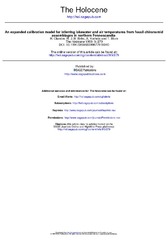An expanded calibration model for inferring lakewater and air temperatures from fossil chironomid assemblages in northern Fennoscandia
Peer reviewed, Journal article
Permanent lenke
https://hdl.handle.net/1956/2506Utgivelsesdato
1999Metadata
Vis full innførselSamlinger
Originalversjon
https://doi.org/10.1191/095968399677918040Sammendrag
Chironomid-temperature inference models based on an expanded data set of surface-sediment and limnological data from 53 Subarctic lakes in northern Fennoscandia have been developed using eight different numerical techniques, each based on slightly different underlying statistical models or ecological assumptions. The study sites are mostly small, shallow, bathymetrically simple, oligotrophic lakes, with a pH range from 5.0 to 7.8, a total organic carbon range from 2.5 to 12.6 mg l- 1, a mean July lakewater temperature ranging from 6.1 to 15.4°C, and a mean July air temperature ranging from 8.5 to 14.9°C. A series of redundancy analyses (RDA) identified sediment organic content, maximum lake depth, and lakewater temperature as being the most important explanatory variables. Variance partitioning by partial RDAs further suggested that each of these variables accounted for a significant fraction of variance independent from each other. Different cali bration models were assessed on the basis of their statistical performance, with particular reference to prediction errors and the amount of bias along the temperature gradient. Of the eight calibration models, modern analogue techniques, weighted averaging partial least squares, simple weighted averaging with an‘inverse’ deshrinking regression, and linear partial least squares consistently performed best. These methods can all be used to develop transfer functions for surface-water and air July temperatures with a root mean squared error of predic tion (RMSEP) of about 1.5–1.6°C (water temperature) and 0.8–1.1°C (air temperature), as assessed by leave-one-out cross-validation. The resulting models do, however, have relatively high maximum biases (up to 3.9°C) in the lowest segments of the air and water temperature gradients, highlighting the need for enlarging and expanding the calibration data set to include lower temperatures.
